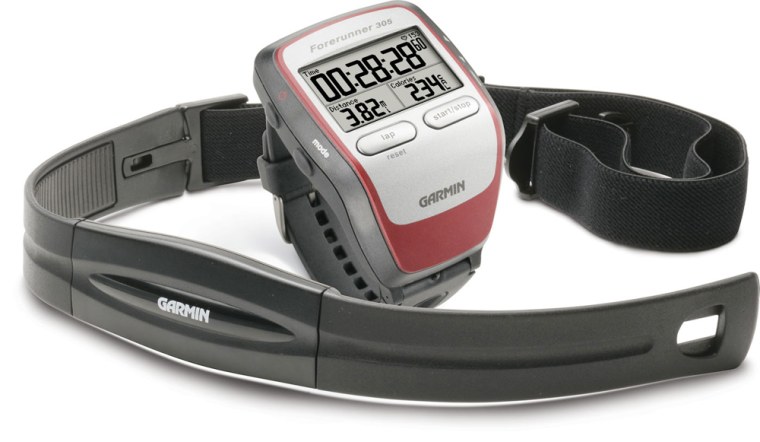We endurance athletes tend to be an obsessive lot. We like training regimens and schedules. We go nuts for calorie counters. We can’t live without mileage trackers. People like us can’t just enjoy the ride — we need to get the data.
Enter the Garmin Forerunner 305, a GPS-enabled trainer for runners, cyclists, hikers, walkers, inline skaters — if you plan to cover any ground outside, the Forerunner can track your route.
Garmin says this $350 whopper-of-a-watch wraps the GPS antenna around part of the wrist for a better view of the sky, and that its high-sensitivity receiver makes for improved tracking under trees and near tall buildings. The Forerunner automatically saves all training data, and can hold up to two years of it in its memory. The unit comes with a USB cable and training software so you can download and analyze your data on your PC or Mac — handy if you’re training for something specific and like to pore over your stats.
Out of the box, the Forerunner 305 takes very little setup to be operational. Before you do anything, you’ll need to charge it for three hours using the supplied USB port (the device has a 10-hour battery life). Each time you go outside, your Forerunner will need to sync up with orbiting satellites, which can takes anywhere from 30 second to a minute or so. From there, just hit start, and you’re off and running.
The Forerunner has a dizzying amount of features, but the device itself has only seven buttons: The on/off switch, a mode button, a lap button, a start/stop button, two arrow keys and an enter button. It’s not the tiniest thing you’ve ever seen — my friend said “Whoa! That’s a computer!” when I strapped this sucker on before our walk. It weighs in at just under 3 ounces and measures 2.1 inches x 2.7 inches. You get used to it.
Garmin ships the device with a highly usable quick-start pamphlet and a more detailed owner’s manual that can help you delve into the Forerunner’s many available options. And for $350, you’re going to want to plumb this gadget for everything it’s got.
The Forerunner 305 has settings specific to running, cycling and “other sports.” I took the Forerunner out for a six-mile run, a 16-mile bike ride and a 3.5-mile walk, so I used all three. For each sport, you can change the speed units and enter extra gear or bike weight, which affects the number of calories you burn.
The Forerunner comes with a dual-sensor chest strap and will track your calorie burn in real-time. Go into the general settings to enter in your gender, age and weight for a more customized count.
That said, the calorie-count feature was the biggest disappointment of the Forerunner: The heart rate display is tiny, and my total calorie burn was suspect. The Forerunner tallied a whopping 700 calories burned during my bike ride, while my trusty Polar heart rate monitor tracked the same ride at just 550 total calories. Sure, I’d like to believe the Forerunner (that’s an extra Mint Milano, after all), but 150 calories is a big discrepancy.
Garmin uses speed traveled — not heart rate — to calculate calorie output on the Forerunner. As a result, you also can’t use it as an indoor heart-rate monitor and calorie counter — unless you buy an accessory called a Foot Pod, which retails for just under $90.
The company acknowledged that the calorie-counting aspect is the weak link of the device, but a free software download, available on their site, apparently improves the accuracy quite a bit.
Calorie-counting aside, the Forerunner's route-tracking and training features are hard to beat. The fact that this device accurately recorded my mileage right out of the box was a huge plus — I used a Nike Tailwind previously and was forever having to recalibrate the thing. Once you have a few courses you like, you can save and race against them, marking points along the way.
You can set up interval workouts with specific distances or time values and desired repetitions. If you’re a triathlete or duathlete, you can set up a multi-sport workout without resetting the timer. You can also use the GPS navigation feature to see your path on a map, save locations you want to remember — and find your way home if you get lost.
The Forerunner also has thoughtful little features that you never thought you needed. For instance, the auto-pause feature stops the timer when you stop moving and restarts again when you get going — great for stoplights and water breaks. There’s also a Virtual Partner that, when enabled, will compete with you during workouts.
Bottom line: If you’re training for a race — or you think a gadget with real-time data might inspire you to hop on your bike more — you can’t do much better than the easy-to-use Forerunner. But the $350 price tag may give you pause if all you want is a way to track your mileage, heart rate and calorie count.
